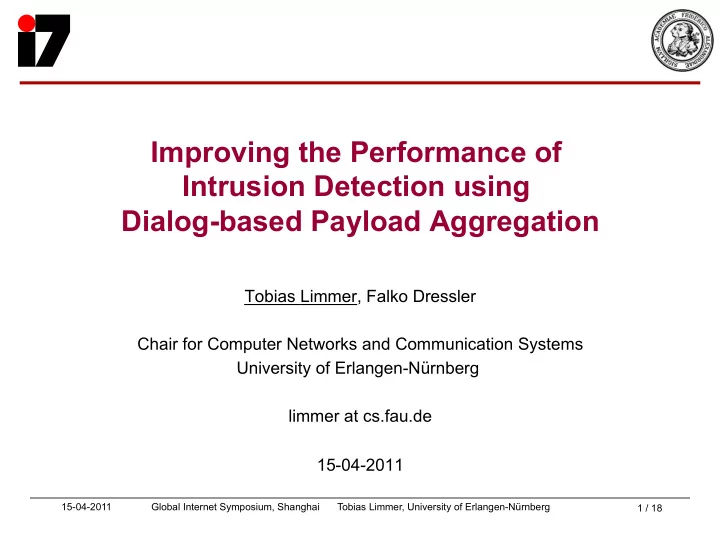

Improving the Performance of Intrusion Detection using Dialog-based Payload Aggregation Tobias Limmer, Falko Dressler Chair for Computer Networks and Communication Systems University of Erlangen-Nürnberg limmer at cs.fau.de 15-04-2011 15-04-2011 Global Internet Symposium, Shanghai Tobias Limmer, University of Erlangen-Nürnberg 1 / 18
Network-based Intrusion Detection Internet 15-04-2011 Global Internet Symposium, Shanghai Tobias Limmer, University of Erlangen-Nürnberg 2 / 18
Motivation Focus on IDS based on payload analysis using signatures Performance problem for these IDSs implemented in software: Processing rate: 200 MBit/s Common data rate of network link: 10 GBit/s ~100 IDS instances needed to analyze fully loaded link (!) Multiple suggestions for improvement already available: FPGAs, graphic cards Improved matching algorithms Filtering based on header data (IP addresses, ports) Parallelization . . . 15-04-2011 Global Internet Symposium, Shanghai Tobias Limmer, University of Erlangen-Nürnberg 3 / 18
Signature-based Detection Typical signature generation process: Similar for all signatures! 15-04-2011 Global Internet Symposium, Shanghai Tobias Limmer, University of Erlangen-Nürnberg 4 / 18
Payload-based IDS Common signature features: Header filters: protocol, IPs, ports Payload matches: simple and with regular expressions match restrictions within packets Popular implementations: Snort, Bro Example signature: alert tcp $EXTERNAL_NET any -> $HOME_NET 21 (msg:"ET EXPLOIT GuildFTPd CWD and LIST Command Heap Overflow - POC-1"; flow:established; content:"cwd" ; depth:4; nocase; dsize:>74; pcre:"/(\/\.){70,}/i" ; sid:2008776; rev:3;) Evasion is possible: Exploitation of protocol ambiguities ( → normalization) Data encryption ( → “SSL-terminators”) Use of unknown attacks / communication protocols ( → anomaly-based IDS?) 15-04-2011 Global Internet Symposium, Shanghai Tobias Limmer, University of Erlangen-Nürnberg 5 / 18
Heavy-tailed Network Traffic “Heavy-hitters” What means heavy-tailed? Pareto-distribution with shape parameter k<2 Multiple parts within a connection: Dialog between server and client Transfer of bulk data Examples: [source: wikipedia.org] HTTP: request/response and URI content from server POP3/IMAP: capability handshake, login, request, mail content Hypothesis: Bulk data not interesting for attack detection! First approach: Capture payload from beginning of connection Examples: Time-Machine, FPA 15-04-2011 Global Internet Symposium, Shanghai Tobias Limmer, University of Erlangen-Nürnberg 6 / 18
Dialog-based Communication Capturing payload from the start of connection is not sufficient Example: HTTP pipelining Make use of typical request-response pattern in protocols! 15-04-2011 Global Internet Symposium, Shanghai Tobias Limmer, University of Erlangen-Nürnberg 7 / 18
Dialog-based Payload Aggregation Capture “dialogs” between communication endpoints Use communication direction for selecting payload On each direction change, start recording n bytes of payload 15-04-2011 Global Internet Symposium, Shanghai Tobias Limmer, University of Erlangen-Nürnberg 8 / 18
Dialog-based Payload Aggregation Application layer analysis is not needed, transport layer contains enough information TCP: sequence numbers UDP: packet order 15-04-2011 Global Internet Symposium, Shanghai Tobias Limmer, University of Erlangen-Nürnberg 9 / 18
Evaluation With live network trace from a University 8 10min packet traces per day over period of 3 months 16.8 TiB of data Anonymized Used three rule sets for Snort Excluded rules that did not match payload for patterns Sourcefire (SF), 5600 rules EmergingThreats (ET), 9400 rules BotHunter (BH), 2500 rules Collected events from 858 rules Filtered all rules with <10 events Analyzed 526 rules 15-04-2011 Global Internet Symposium, Shanghai Tobias Limmer, University of Erlangen-Nürnberg 10 / 18
Dialog Segments 1 100 ● ● ● ● ● ● ● ● ● ● ● ● ● ● ● ● ● ● ● ● ● ● ● ● ● ● ● ● ● 80 ● ● ● ● ● 60 ecdf (%) 40 all ● HTTP SSH 20 SMTP FTP control ● HTTPS 0 ● 0 5 10 15 20 25 30 35 # dialog segments per connection 15-04-2011 Global Internet Symposium, Shanghai Tobias Limmer, University of Erlangen-Nürnberg 11 / 18
Dialog Segments 2 100 ● ● ● ● ● ● ● ● 80 ● ● ● ● ● ● ● ● ● ● ● ● ● 60 ● ecdf (%) ● ● ● ● 40 all ● HTTP SSH ● 20 ● SMTP To Server To Client 0 ● ● 0 500 1000 1500 2000 dialog segment length (bytes) 15-04-2011 Global Internet Symposium, Shanghai Tobias Limmer, University of Erlangen-Nürnberg 12 / 18
DPA Data Reduction DPA / orig. data (%) 80 40 0 # det. events (%) 80 all HTTP 40 SSH SMTP IRC 0 0 1000 2000 3000 4000 DPA maximum dialog length (bytes) 15-04-2011 Global Internet Symposium, Shanghai Tobias Limmer, University of Erlangen-Nürnberg 13 / 18
DPA Detection Evaluation IDS signature match position relative to start of dialog segment Only 1/20 of network data was analyzed by IDS 9 out of 10 events were still detected! 15-04-2011 Global Internet Symposium, Shanghai Tobias Limmer, University of Erlangen-Nürnberg 14 / 18
DPA Performance 15-04-2011 Global Internet Symposium, Shanghai Tobias Limmer, University of Erlangen-Nürnberg 15 / 18
Conclusion Introduced Dialog-based Payload Aggregation (DPA) Works out-of-the-box with popular IDSs! Results with 2000 byte boundary: 96% of traffic was filtered out 90% of events were detected Problematic events: Shellcode, False-positives Future work: Add new match position restriction to signatures which is relative to start of dialog segments Use for forensic analysis Combine DPA with other intrusion detection methodologies 15-04-2011 Global Internet Symposium, Shanghai Tobias Limmer, University of Erlangen-Nürnberg 16 / 18
The End Thanks for your attention! Questions? 15-04-2011 Global Internet Symposium, Shanghai Tobias Limmer, University of Erlangen-Nürnberg 17 / 18
DPA Detection Evaluation 2 Comparison: relative to connection start relative to dialog segment start 15-04-2011 Global Internet Symposium, Shanghai Tobias Limmer, University of Erlangen-Nürnberg 18 / 18
Recommend
More recommend